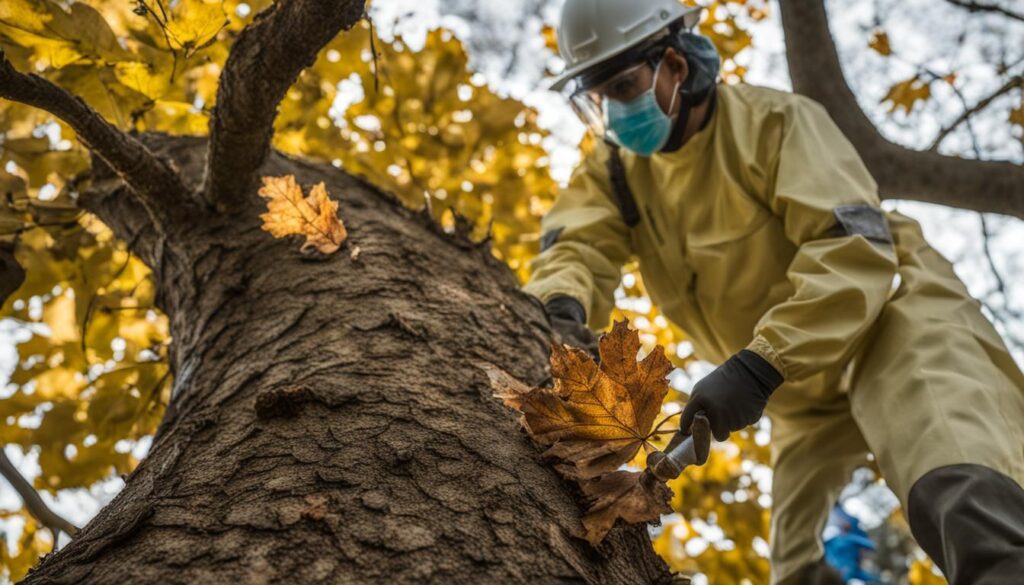As a tree enthusiast, I understand the importance of keeping our oak trees healthy and thriving. One of the most significant threats to oak trees is oak wilt, a dangerous and deadly fungus that can quickly spread and infect these majestic beauties. To ensure the well-being of our oaks, it is crucial to identify oak wilt early and take immediate action. In this article, I will guide you through the process of identifying oak wilt, equipping you with the knowledge to spot the signs and symptoms before it’s too late.
Key Takeaways:
- Recognizing the signs and symptoms of oak wilt is essential for preserving the health of oak trees.
- Early identification allows for timely treatment and management strategies to save infected trees when possible.
- Regular tree inspections and proper pruning techniques are vital for preventing the spread of oak wilt.
- Diagnosis through laboratory tests can provide accurate identification of oak wilt.
- Preventive measures include cutting down infected trees, avoiding pruning during certain months, and using fungicide injections.
What is Oak Wilt?
Oak wilt is a tree disease caused by the fungus Ceratocystis fagacearum. It primarily affects oak trees, targeting their water-conducting systems. This destructive fungus can quickly spread and lead to the death of infected trees. While all oaks are susceptible to oak wilt to some extent, certain species, such as Texas oak and red oak, are particularly vulnerable. Understanding the nature of this tree disease is vital for effective prevention and management.
Infected trees often display symptoms such as wilting leaves, discoloration, and defoliation. The fungus disrupts the water-conducting systems of oak trees, hindering their ability to transport vital nutrients and water throughout the tree. As a result, the infected trees gradually decline and may eventually die.
Preventing the spread of oak wilt requires careful monitoring, prompt identification, and appropriate management strategies. By recognizing the signs and symptoms of oak wilt, tree owners can take immediate action to protect their beloved oaks and preserve the beauty of their landscapes. In the following sections, I will delve deeper into the symptoms and spread of oak wilt, as well as effective techniques for diagnosis, prevention, and treatment.
Symptoms of Oak Wilt
The symptoms of oak wilt can vary depending on the tree species. In live oaks, the leaves may develop yellow veins that eventually turn brown, leading to rapid defoliation. Red oaks may experience wilting and discoloration of young leaves, along with the development of fungal mats beneath the bark. These fungal mats produce a fruity odor and attract insects that can spread the disease to other trees.
How Oak Wilt Spreads
Oak wilt, a devastating fungal disease, spreads through various means, posing a significant threat to oak trees. One primary mode of spread is through fungal mats that form beneath the bark of infected trees. These mats, visible as inconspicuous raised areas on tree trunks, serve as breeding grounds for insects.
Insects, particularly sap-feeding beetles, are attracted to these fungal mats. As they feed on the mats, they unwittingly pick up the oak wilt fungus on their bodies and transfer it to healthy trees they infest. This mode of transmission makes the insects inadvertent carriers of the disease, aiding in its rapid spread.
Another significant route of oak wilt spread is through interconnected root systems. In live oak trees, specifically, roots can graft together, forming a network that allows the disease to move from infected trees to healthy ones. The fungus utilizes these interconnected root systems to transport itself, infecting adjacent trees in the process.
Moreover, oak wilt can be transmitted through direct contact with infected wood. When healthy oak trees come into contact with wood from infected trees, such as through firewood or during pruning activities, the fungus can be transmitted. This direct transmission pathway underscores the importance of proper disposal and precautions when dealing with infected wood.
Fungal mats: Dangerous attractants
Fungal mats beneath the bark of infected oak trees are a distinctive feature of oak wilt. While they may appear harmless, they play a vital role in the spread of the disease. These mats are comprised of fungal spores that can infect other trees. They also emit a distinctive odor, similar to fermenting fruit, attracting sap-feeding beetles, which then serve as carriers for the disease.
It’s crucial to remember that fungal mats should not be disturbed or removed manually. Instead, consult a professional arborist to handle the removal and treatment process.
Understanding the various modes of spread is essential for effectively combating oak wilt. By addressing fungal mats, controlling insect populations, preventing root transmission, and taking proper precautions when handling infected wood, we can limit the spread of this destructive disease.
Diagnosis and Laboratory Tests
Diagnosing oak wilt can be challenging without laboratory tests. To confirm the presence of oak wilt, wilting branch samples can be submitted to a laboratory for analysis. These samples should be actively wilting and approximately half an inch in diameter.
It is important to keep the samples cool until shipping and send them overnight to maintain their freshness. Laboratory tests can provide accurate identification of oak wilt, especially for white and bur oak species. This diagnostic approach ensures a precise diagnosis, enabling targeted treatment and effective management strategies.


By utilizing laboratory tests, arborists and tree care professionals can confidently identify oak wilt and differentiate it from other diseases that may share similar symptoms. Collaborating with a reputable laboratory and following their testing protocols is essential for accurate results, enabling timely interventions to prevent the spread of oak wilt and preserve the health of surrounding trees.
Preventing Oak Wilt
Preventing oak wilt is crucial for protecting the health of your trees and preventing the spread of this destructive disease. To effectively prevent oak wilt, it is important to implement a combination of strategies:
Cutting down infected trees: If you have identified an oak tree with oak wilt, it is essential to promptly cut down and dispose of the infected tree. Proper disposal is crucial to prevent further spread of the disease.
Avoiding pruning during certain months: Pruning oak trees during the active period of sap-feeding beetles increases the risk of oak wilt transmission. It is recommended to avoid pruning oak trees from February to June when these beetles are most active.
Fungicide injections: For high-value oak trees, such as those in urban areas or near valuable structures, fungicide injections can be used as a preventive measure. Propiconazole is an effective fungicide commonly used to protect oak trees from oak wilt.
Avoiding storing firewood near healthy oak trees: Firewood from infected oak trees can harbor the oak wilt fungus. To prevent the accidental spread of the disease, it is important to avoid storing firewood near healthy oak trees.
Planting a diverse range of tree species: Planting a variety of tree species in your landscape can help reduce the risk of oak wilt. Some tree species are naturally resistant to oak wilt, and their presence can contribute to a healthier and more resilient tree community.
Implementing these preventive measures can significantly reduce the risk of oak wilt in your trees. By taking proactive steps to prevent oak wilt, you can maintain the health and longevity of your oak tree population.
Treating Oak Wilt
When it comes to dealing with oak wilt, a combination of techniques is often necessary to effectively treat the disease. One of the primary methods is trenching, which involves creating a trench around infected trees. This trench should be at least 4 feet deep and extend 100 feet beyond the center of infection. By doing so, we can disrupt the spread of oak wilt through the root systems, helping to contain the disease.
In addition to trenching, fungicide injections can be used to treat susceptible trees. Fungicides containing propiconazole are commonly employed in these injections. This treatment is particularly useful for trees that hold high value, such as those in commercial or residential areas. The fungicide injections help protect the tree’s water-conducting tissues, preventing further damage from oak wilt.
Another vital aspect of oak wilt treatment is the use of resistant tree species. By planting resistant trees on your property, you can proactively prevent the onset of oak wilt. Resistant tree species are less susceptible to the disease and can help protect other trees in the vicinity. Consider consulting with a local arborist or tree specialist to choose the best resistant tree species for your region.


By combining trenching, fungicide injections, and resistant tree species, you can take proactive measures to treat and prevent oak wilt. Remember, early detection and prompt action are key to preserving your oak trees and maintaining the health of your tree landscape.
Regular Tree Inspections and Proper Pruning Techniques
Regular tree inspections play a vital role in the early detection of tree diseases, including oak wilt. By monitoring the health of your trees, you can identify any signs of distress or infection, allowing you to take proactive measures to prevent the spread of diseases and protect the overall well-being of your trees.
During these inspections, pay close attention to any changes in the foliage, such as wilting leaves or discoloration. Additionally, look for physical symptoms like fungal mats or cracks in the bark, as these can be indicative of oak wilt. By catching these early warning signs, you can act swiftly to mitigate potential damage and preserve the health of your trees.
Proper pruning techniques are also essential for minimizing the risk of oak wilt transmission. When pruning your trees, it is crucial to avoid creating wounds during the active beetle season, typically from February to June. This precaution helps prevent sap-feeding beetles, which can carry the oak wilt fungus, from being attracted to the fresh cuts.
When pruning, make sure to remove dead or diseased branches promptly. Using clean, sharp tools, make angled cuts just outside the branch collar, without leaving stubs that can serve as entry points for disease. Proper pruning not only helps prevent oak wilt but also promotes healthy growth and improves the overall aesthetics of your trees.
Regular tree inspections and following proper pruning techniques are vital steps in maintaining the health and vitality of your trees. By being proactive in your approach, you can effectively prevent the spread of oak wilt and other tree diseases, ensuring the long-term beauty and sustainability of your tree landscape.
Importance of Oak Wilt Identification for Tree Health
Identifying oak wilt early is essential for maintaining the health of your trees. By recognizing the signs and symptoms of oak wilt, you can take immediate action to prevent the spread of the disease and protect other trees in your area. Early identification also allows for timely treatment and management strategies to save infected trees when possible.
Oak wilt is a destructive tree disease caused by the fungus Ceratocystis fagacearum. It primarily affects oak trees, compromising their water-conducting systems and eventually leading to their death. By identifying oak wilt early on, you can effectively manage its spread and prevent further tree loss.
The visual cues of oak wilt, such as yellowing and browning leaves, wilting, and the formation of fungal mats, serve as warning signs. By being vigilant and regularly inspecting your trees, you can promptly spot these symptoms and take appropriate measures to mitigate the disease’s impact.
Early oak wilt identification is crucial not only for preserving the health and vitality of individual trees but also for preventing the spread of the disease to nearby oaks. By acting swiftly and implementing preventative measures, such as proper pruning techniques, avoiding pruning during certain months, and ensuring a diverse range of tree species on your property, you can effectively protect your trees from this devastating disease.
By proactively identifying oak wilt and promptly addressing its presence, you contribute to the overall health and resilience of your tree community. Preventing tree diseases like oak wilt safeguards the beauty of your landscape and the ecosystem services provided by trees, such as shade, clean air, and wildlife habitat.
Conclusion
In conclusion, oak wilt identification is paramount for preserving the health and beauty of your oak trees. By familiarizing yourself with the signs, symptoms, and preventive measures, you can effectively combat this devastating tree disease. Conducting regular inspections and practicing proper pruning techniques are crucial for early detection and prevention. Prompt treatment, including fungicide injections and appropriate tree removal, can help contain the spread of oak wilt and protect the surrounding trees.
Taking a proactive approach to oak wilt identification and prevention is essential for maintaining the longevity of your tree landscape. By staying vigilant and staying informed, you can take immediate action to save your valuable oak trees from the devastating effects of oak wilt. Remember to monitor your trees closely, follow recommended pruning practices, and seek professional assistance for accurate diagnosis and treatment when needed. With these measures in place, you can keep your trees healthy and thriving for years to come.
Early detection is the key to mitigating the impact of oak wilt on your trees. By understanding the visual cues and signs of oak wilt, such as wilting leaves, discoloration, and the presence of fungal mats, you can take proactive steps to prevent the disease from spreading further. Whether it’s through regular inspections, proper pruning techniques, or seeking professional advice, your diligence in oak wilt identification and tree disease prevention will ensure the long-term health and vitality of your oak trees.
FAQ
What are the symptoms of oak wilt?
The symptoms of oak wilt can vary depending on the tree species. In live oaks, the leaves may develop yellow veins that eventually turn brown, leading to rapid defoliation. Red oaks may experience wilting and discoloration of young leaves, along with the development of fungal mats beneath the bark.
How does oak wilt spread?
Oak wilt can spread through fungal mats that form under the bark of infected trees. Insects, particularly sap-feeding beetles, are attracted to these fungal mats and can carry the disease to healthy trees. Oak wilt can also spread through interconnected root systems, especially in live oak trees. Additionally, the disease can be transmitted when infected wood is in contact with healthy oak trees, such as through firewood or pruning wounds.
How can oak wilt be diagnosed?
Diagnosing oak wilt can be challenging without laboratory tests. Wilting branch samples can be submitted to a laboratory for analysis to confirm the presence of oak wilt. These samples should be actively wilting, approximately half an inch in diameter, kept cool until shipping, and sent overnight.
What are the preventive measures for oak wilt?
Preventing oak wilt involves several strategies. Infected red oak trees should be cut down and disposed of properly to prevent further spread. Avoid pruning oak trees from February to June when sap-feeding beetles are most active. For high-value trees, fungicide injections with propiconazole can be used as a preventive measure. It is also important to avoid storing firewood near healthy oak trees and to plant a diverse range of tree species that are resistant to oak wilt.
How can oak wilt be treated?
Treating oak wilt involves a combination of techniques. Trenching around infected trees at least 4 feet deep and 100 feet beyond the infection center can help stop the spread of the disease through root systems. Fungicide injections with propiconazole can be used to treat susceptible trees, particularly those of high value. Planting resistant tree species on your property can also help prevent the onset of oak wilt.
Why are regular tree inspections and proper pruning techniques important?
Conducting regular tree inspections is crucial for detecting oak wilt and other tree diseases early. By monitoring the health of your trees, you can take proactive measures to prevent the spread of oak wilt. Additionally, following proper pruning techniques, such as avoiding pruning wounds during the active beetle season, can minimize the risk of oak wilt transmission.
Why is oak wilt identification essential?
Identifying oak wilt early is essential for maintaining the health of your trees. By recognizing the signs and symptoms of oak wilt, you can take immediate action to prevent the spread of the disease and protect other trees in your area. Early identification also allows for timely treatment and management strategies to save infected trees when possible.



